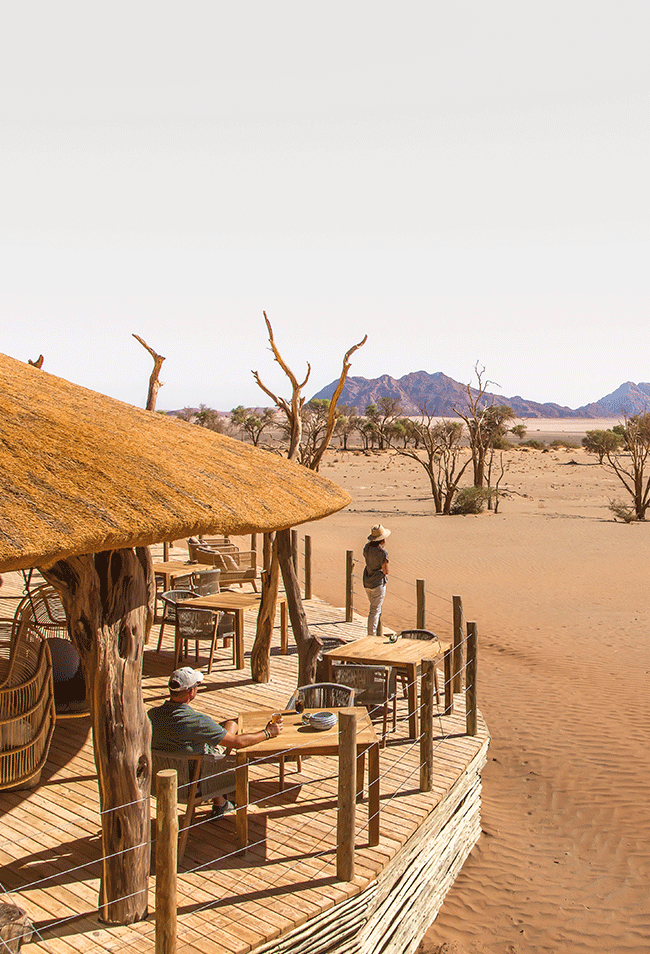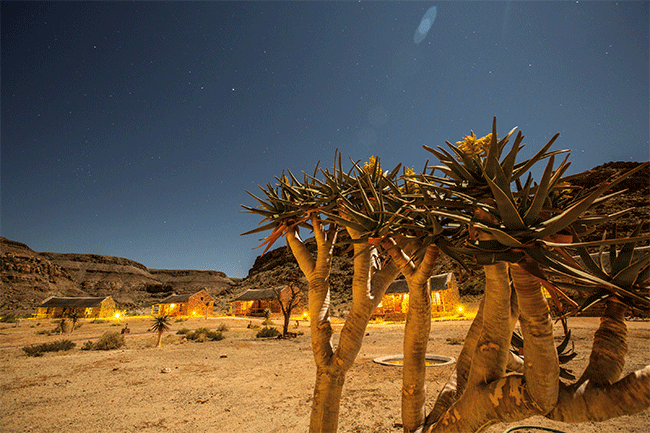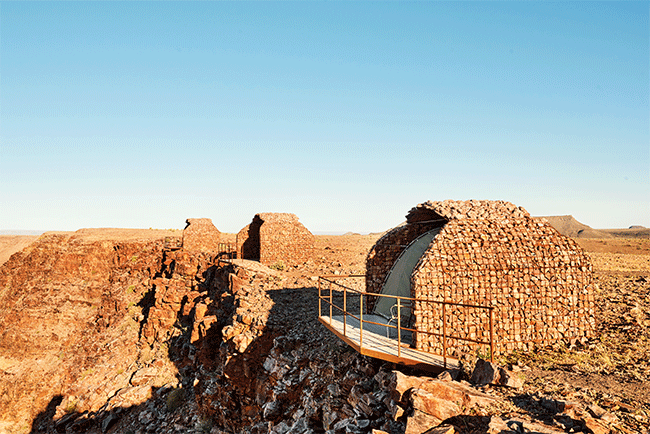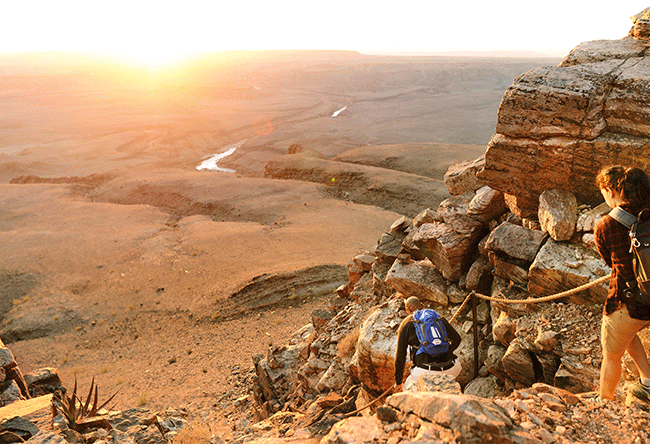For South Africans, Namibia is an easy sell – no visa requirements; the rand is accepted everywhere; and border controls are mostly straightforward. And it’s not just for camping overlanders either. Anyone in a competent SUV with decent tyres can tour the region. Equally, it needn’t be a rough-it experience; Namibia boasts a plethora of sophisticated accommodation options, good for cosmopolitan travellers looking for comfort and a degree of class.
The Fish River Canyon, Lüderitz, Sossusvlei and Swakopmund … a potent southern quartet. Most travellers use the B1 national road from the SA border at Vioolsdrif as their anchor, detouring off it to reach these attractions, yet there’s a more interesting way around. From Vioolsdrif the adventurous drive west towards Rosh Pinar on the C13, through the Ai|Ais/Richtersveld National Park, approaching the Fish River Canyon from the west. The well-kept C13 dirt road is perfectly passable, and the benefits are many. Apart from the magnificence of a towering, 2 billion-year-old landscape unlike any other on Earth, there are fantastic views of the Orange river and bragging rights for being one of only a few who ever make it to the eastern edge of the Fish River Canyon.
Actually, a Namibian desert road trip begins in SA. Up the N7 from Cape Town, the draw of Namaqualand is strong, and a diversion to Platbakkies Guest Farm is a very good idea. The farm stay on the Namaqualand/Bushmanland border is run by Dawie and Lizelle Burden and comprises an entire farmhouse, so privacy is guaranteed. The tranquillity of Bushmanland, the design and attention to detail in the guesthouse, the warm welcome… And it’s cool. Literally. At 1 060m, Platbakkies doesn’t get ridiculously hot. In fact, the cooling Namaqua ‘air con’ blowing from the West Coast makes it very pleasant.
From Platbakkies the R355 to Springbok is spectacular, and as you reach Springbok, the Goegap Nature Reserve delivers those iconic boulder landscapes this part of the Northern Cape is known for. Those outcrops occur all the way to the border and beyond – a precursor to the ancient igneous, volcanic Richtersveld which itself extends up the coast from Oranjemund. Driving through the terrain is to leave Earth and explore another planet. By the time the Fish River Canyon presents itself, the landscape will have worked its magic – no stress; a clear mind.
The Fish River Canyon Lodge, operated by Journeys Namibia, comprises 19 chalets literally hanging off the edge of the canyon rim. Over on the eastern edge the popular Gondwana properties are far back from the edge – this is the only property where guests can fall asleep in chic, contemporary chalets and wake up to unforgettable vistas at the foot of their bed. North and south of the lodge are trails that follow the canyon edge, meaning every walk offers up stunning outlooks. It’s also possible to do the trails by mountain bike or book an excursion down onto the canyon floor by safari vehicle.
From the Fish River Canyon to Lüderitz, the routing dips into the desert proper, skirting the Namib-Naukluft National Park. It’s a wonderful drive – on the way the ageless, obsessively clean Bahnhof Hotel in the village of Aus is a must for tea and cake on the stoep, and the historical railway station of Garub is well worth a photo stop. Unlike Kolmanskop just down the road, it is deserted as well as abandoned, with no ant-like tourists climbing over the ruins. It’s also free – again, unlike Kolmanskop, which the Namibian authorities, in their wisdom, charge an arm and a leg for and continue to price ordinary travellers out of the market.
That said, the deserted village of Kolmanskop is an eerie, evocative place – a lesson in the vagaries of exploitative mining. Diamonds brought thousands of fortune-seekers to the area in the early 1900s, but the abundance was soon exhausted and the town fell into ruin. Visited before Lüderitz it also serves as a foretaste of the latter’s ‘Gründerzeit’ architecture, German colonial edifices that were meant to trumpet the owners’ wealth and importance, first from guano, then from mining.
It’s a delightfully quirky coastal enclave, buildings such as Krabbenhöft & Lampe, the Felsenkirche and Hans Goerke’s nouveau riche diamond palace seemingly at odds with the remote location. Like most of the diamond palaces in town, the sophisticated Alte Villa guesthouse was built to lend its 1909 diamond rush owners a certain cache – in this instance, merchants from Hamburg. It’s been beautifully restored and extended (the loft suite in particular, with its special views over Robert Harbour) and the antiques are spot on for the period. Best of all is the biggest bathroom this side of the Kavango, though the bath may be a luxury too far – surrounded by sea, Lüderitz has no potable water of its own.
From Lüderitz the trip to the dunes of Sossusvlei is a seven-hour drive, skirting the NamibRand Nature Reserve. The Namib’s presence makes itself felt from Hammerstein, with its characteristic dolomite outcrops in fields of grass and, as you reach Sossusvlei, the coastal red dunes, made up of sands transported down the Orange river from as far away as the Drakensberg.
Little Kulala, Wilderness’ exclusive Sesriem property, is on Sossusvlei’s doorstep – part retreat, part gateway to the dunes. Renovated just before the pandemic, it’s contemporary yet cosy, well integrated into the landscape. Huge, spacious chalets set apart from each other offer views across the empty plains of the lodge’s reserve, and there’s an excellent spa to boot. Tour the reserve by safari vehicle, electric bike or on foot (day and night) or take a hot-air balloon early one morning. But really the lodge’s point of difference is its staff, experts on the area’s history, geography and culture. The privilege of having your own walking encyclopaedia cannot be overstated – learn all about the deepest recesses of a sociable weaver nest, the geomorphology of the elephant skin boulders, how the shepherd tree beats the drought.
Sossusvlei at sunrise is one of life’s must-dos. The reserve opens early to catch the spectacle, and vehicles hurry down ‘dune alley’ towards the largest of the looming giants. And Deadvlei, the much-photographed dry pan under the biggest of all the dunes, Big Daddy. As the first rays break cover, the world turns Mars red, offering up a landscape of sharp contrasts and beautiful shadowlands. Hiking up the 300m-high Big Daddy behemoth is a rite of passage but be warned, it’s no stroll in the park – certainly it would be mad to attempt any time after 10 am, especially in summer. Left and right the unprepared go through all of Kübler-Ross’ stages of grief, convinced they are going to expire on the world’s second-highest dune. It’s worth it though. From the summit there are concertinas of red dunes as far as the eye can see, the real Namib and Atlantic coast disappearing into the distance.
After the magnificence of Sossusvlei, the five-hour drive to Swakopmund is likely to be an anticlimax, but Solitaire padstal, that famed stop-off en route, lifts the spirits. Die ‘beroemde appeltert’ is indeed worth the money, and the littering of classic car carcasses will delight petrolheads everywhere.
The coast is something of a paradigm shift – after the elegant emptiness of the desert, first Walvis Bay and then its sister town Swakopmund are a shock to the system. The discombobulation soon passes – the latter is a delightful higgledy-piggledy disarrangement of architectural styles, antiquey junk shops, promenades, hidden courtyards and the cold Atlantic, which lends it a curiously European flavour.
Much of the time the chilly onshore affords the town a temperate, if not downright chilly, ambience. It’s popular with the second-life refugees, German émigrés in colourful headscarves tanning themselves on the town’s central beach. It’s great for eating and drinking too. Slowtown Coffee is as trendy as downtown Woodstock in Cape Town, Kücki’s Pub has been serving Atlantic sole for 40 years, the wildly popular Tug Restaurant at the base of the famous pier has a waiting list to rival Fyn, and Lappies Labuschagne at the Trading Post on Bismarck St does a roaring trade in exotic salads. Swakopmund’s allure is its cosmopolitan air, but it’s also the gateway for boat trips in Walvis Bay, the dune-bashing adventures at Langstrand and trips down into the other-worldly Moon Landscape, half an hour outside town, to see the welwitschias.
Anchoring the entire town is the Strand Hotel, prominent on the Swakopmund mole, a promontory in the bay. It’s something of an institution, the obvious choice for well-heeled travellers. And yet it’s a pleasant surprise, suffering from neither the anonymity nor complacency that bedevils so many corporate hotels. It’s a solidly excellent proposition, the design and decor first-rate, quality materials used creatively. Suites all have excellent views of the town or ocean.
Coastal culture done, it’s homeward bound. The stretch to the SA border down the main B1 bisects both Mariental and Grünau, towns as different as they are remote. Grünau is all but deserted, save for the southeaster through the Karasburg grasses. Mariental’s star turn is the indefatigable Padlangs padstal, place of music, alpacas, killer koeksusters and a petting zoo. It’s also close to the Stampriet historical guesthouse. Most people stay over at Gondwana’s very good Canyon Lodge, but Stampriet has its own charms. Huge apiesdoorns, G&Ts on the veranda and a very good, double-volume restaurant. Lamb chops with everything.
The final sweep down to the Orange river is through a landscape of singular beauty – horizons as satisfyingly modernist as a Breuer sculpture. It’s this uncluttered simplicity that has a lasting impact, true for the whole of Namibia. Space to breathe. The finest reason to travel. Namibia’s enduring appeal.













